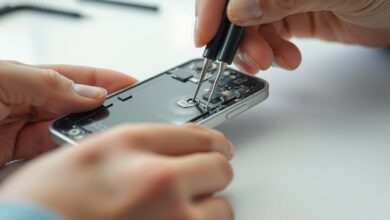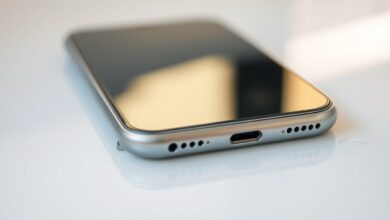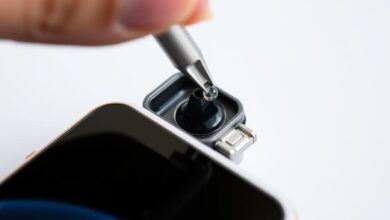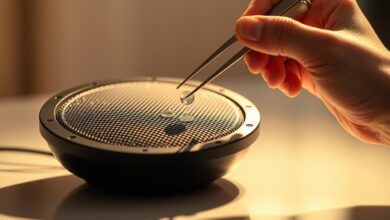how to get water out your iphone
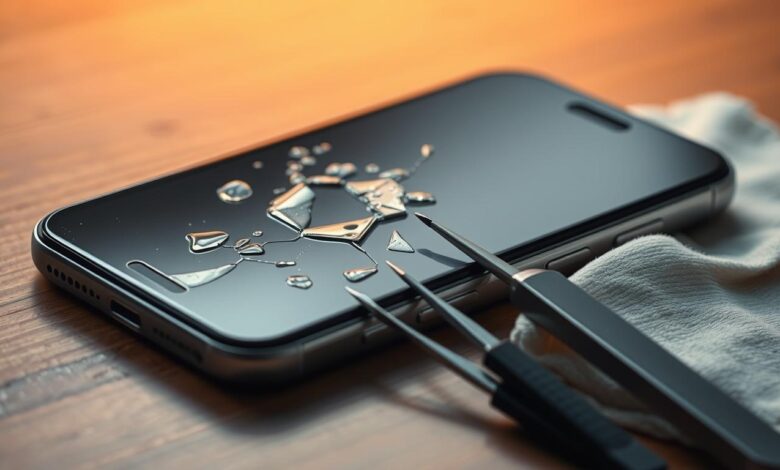
Accidental drops in the bathtub or unexpected downpours can be disastrous for your iPhone. Water damage is a common issue that can render your device unusable. However, with prompt action and the right steps, you can rescue your iPhone and get it working again.
I will walk you through the steps to effectively dry out your iPhone. Understanding the extent of the damage is crucial, and acting quickly can significantly improve the chances of a successful water damage repair iPhone.
Key Takeaways
- Act quickly to minimize damage
- Turn off your iPhone immediately
- Avoid charging your iPhone
- Use desiccants to dry out your iPhone
- Consider professional help if necessary
Understanding iPhone Water Damage
Knowing how water damage affects your iPhone is key to fixing it. Water damage can cause small problems or make your device stop working altogether.
How Water Affects iPhone Components
Water can harm your iPhone’s inside parts. When water gets in, it can cause corrosion and short circuits. The logic board, your iPhone’s brain, is especially at risk.
Corrosion can spread fast, damaging other parts like the battery, screen, and charging port.
Some common problems from water damage are:
- Faulty charging ports
- Screen malfunctions
- Battery drain or failure to charge
- Camera issues
Water Damage Indicators on iPhones
iPhones have special indicators that change color when wet. These Liquid Contact Indicators (LCIs) are found inside the SIM card tray or on the logic board. If your iPhone has been wet, these indicators can show how bad the damage is.
Signs of water damage include:
- Corrosion on the logic board
- Water spots on the screen
- Faulty charging or connectivity issues
To learn more about keeping your iPhone safe, check out iPhone case options that can help prevent water damage.
Act Fast: Immediate Steps After Water Exposure
Acting quickly is key to avoid permanent damage from water on your iPhone. The first few minutes after water exposure are crucial. They decide how much damage will happen.
Turn Off Your iPhone Immediately
The first thing to do is turn off your iPhone right away. This stops short circuits that could harm it more. If it’s still on, turn it off fast. If it’s off, don’t turn it on until it’s dry.
Remove Case and Accessories
Then, take off any cases or accessories that hold water against your iPhone. This includes SIM cards, SD cards, and other parts. Taking these off helps dry your iPhone better.
Wipe External Moisture
Finally, gently wipe off any visible moisture from your iPhone’s outside with a soft cloth. Don’t push water into openings. This step is important to keep water out of your iPhone.
By taking these quick steps, you can lower the chance of water damage to your iPhone. Quick and careful action is essential to remove water from your iPhone and help it recover.
Don’t Make These Common Mistakes
Water damage can be a nightmare for iPhone users. Knowing what mistakes to avoid can save your device. When your iPhone gets wet, what you do next is key to its survival.
Avoid Turning On Your Device
One big mistake is turning on your iPhone right after it gets wet. This can cause a short circuit and more damage. It’s crucial to keep your device off until it’s safe to turn it back on.
Don’t Charge Your Wet iPhone
Charging a wet iPhone is another big mistake. Water and electricity can harm your device’s internal parts. Wait until your iPhone is completely dry before charging it.
Skip the Hairdryer and Heat Sources
Using a hairdryer or other heat sources to dry your iPhone is not a good idea. Heat can push water deeper into the device, causing more damage. Look for safer and more effective drying methods instead.
| Common Mistake | Potential Damage | Recommended Action |
|---|---|---|
| Turning on the device | Short circuit, component damage | Keep the device off until it’s dry |
| Charging a wet iPhone | Electrical shock, component damage | Wait until the device is dry |
| Using heat sources to dry | Pushes water further in, damages components | Use alternative drying methods |
Avoiding these common mistakes can greatly improve your iPhone’s chances of recovery from water damage. For more iphone water removal tips, explore other drying methods and techniques. These are designed to dry out your iPhone safely and effectively.
How to Get Water Out Your iPhone Using Rice Method
Using rice to dry a wet iPhone is a common fix, but it’s not foolproof. Water damage can happen quickly, especially in the first few minutes. The rice method can help, but it’s not a sure thing.
Preparing the Rice Bath
You’ll need a big container to hold your iPhone and rice. Use uncooked rice because it’s dry and good at soaking up moisture. Put 2-3 inches of rice at the bottom, then your iPhone, and finally more rice to cover it.
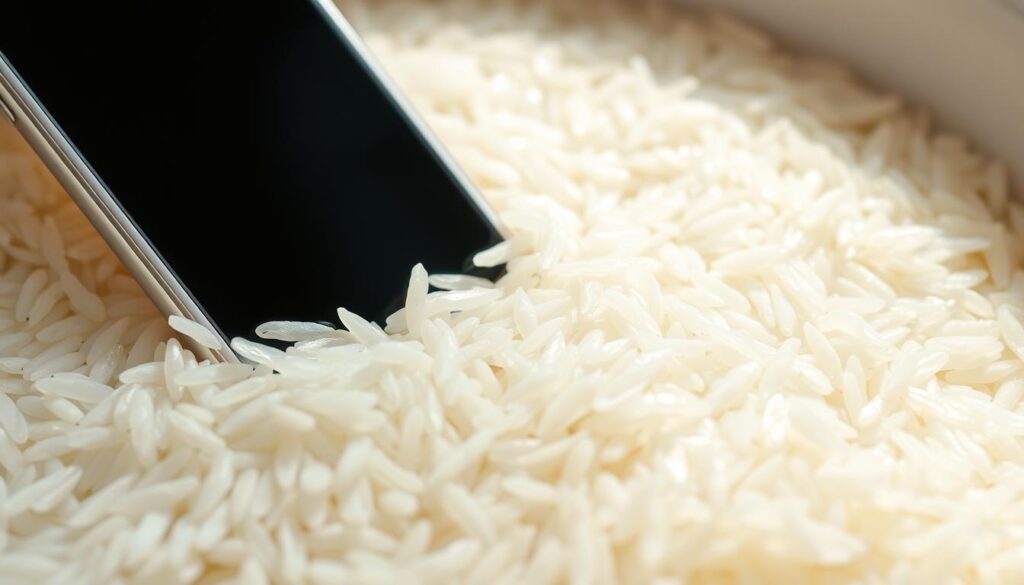
Proper Placement and Duration
How you place your iPhone in the rice and for how long matters. It’s best to leave it in the rice for 48 to 72 hours. This gives the rice enough time to soak up the moisture.
| Duration | Effectiveness |
|---|---|
| 24 hours | Limited moisture absorption |
| 48-72 hours | Optimal moisture absorption |
| More than 72 hours | Minimal additional benefit |
Limitations of the Rice Method
The rice method has its downsides. It might not work if water gets to the iPhone’s internal parts. Also, rice can get stuck in ports and crevices, causing more harm.
Remember, the rice method is not a replacement for professional repair. If your iPhone was in water for a long time or you’re not sure about the damage, see a pro.
Silica Gel: A More Effective Drying Agent
Looking for a better way to dry your iPhone? Try silica gel, a top-notch drying agent. It’s more effective than rice because it absorbs moisture better.
Silica gel packets are great for keeping things dry. They’re often used to control humidity in packaging. This makes them perfect for drying your iPhone.
Where to Find Silica Gel Packets
Silica gel packets are in many things, like shoe boxes and electronic packaging. You can also buy them online or at hardware stores. Get enough to cover your iPhone fully.
Setting Up a Silica Gel Drying Chamber
To create a drying chamber, use a container with a lid. A plastic box or a glass jar works well. Fill it with silica gel packets to surround your iPhone. Then, seal it to keep it dry.
Expected Drying Time
Drying time with silica gel depends on the damage and how many packets you use. It usually takes 24 to 48 hours. Be patient and don’t check on it too often to avoid messing up the drying.
Using Vacuum Methods to Extract Water
Using vacuum methods to get water out of your iPhone is worth trying. If your iPhone gets wet, acting fast is key to less damage. A vacuum can help pull moisture out of your device.
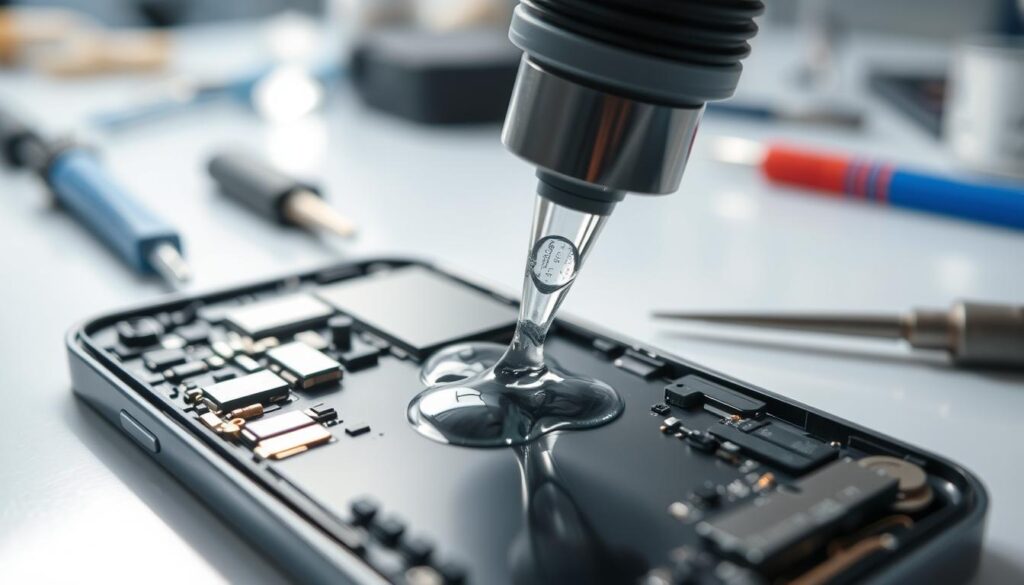
Low-Pressure Vacuum Techniques
Low-pressure vacuum techniques use a vacuum cleaner to carefully pull water out of your iPhone’s openings. You’ll need a vacuum with a low-pressure setting to avoid harming your device’s inside parts. It’s important not to push the vacuum nozzle too hard into the openings, as it could push dirt in or harm the inside parts.
To remove water, use the vacuum’s nozzle to gently pull water from the charging port, SIM card slot, and other openings. You might also use a small tube or adapter for tighter spots. The goal is to get as much water out as you can without pushing it deeper into the device.
| Vacuum Technique | Description | Precautions |
|---|---|---|
| Low-Pressure Suction | Gently suck out water from ports and crevices | Avoid direct contact with internal components |
| Using a Tube or Adapter | Access tighter spaces for better water removal | Be cautious not to push debris further in |
Safety Precautions When Using Vacuums
Using a vacuum can be helpful, but safety is key to avoid more damage to your iPhone. Never use a high-pressure vacuum setting, as it can damage internal parts or push water deeper. Also, be careful not to touch the vacuum nozzle to the iPhone’s screen or other sensitive areas.
As
“The key to successfully removing water from your iPhone is to act quickly and be gentle to avoid causing additional damage.”
This careful approach can help reduce damage and increase your device’s chances of recovery.
By following these tips and being aware of the risks, you can use vacuum methods as part of your iPhone water damage solution to remove water from your iPhone.
Commercial Drying Solutions and Kits
Commercial drying kits are a great help for iPhone users with water damage. These kits aim to dry out iPhones that have gotten wet.
Popular Water Damage Rescue Kits
Many iPhone users have found success with certain drying kits. Here are some of the most popular ones:
- Water Damage Rescue Kit by iRescue: It’s known for drying iPhones fast.
- Desiccant Drying Kit by DryPro: It uses special technology to pull out moisture.
These kits usually come with easy-to-follow instructions.
Cost vs. Effectiveness Analysis
When picking a drying kit, think about the cost and how well it works. Some kits cost more but work better at fixing water-damaged iPhones.
| Kit Name | Cost | Success Rate |
|---|---|---|
| iRescue Kit | $50 | 90% |
| DryPro Kit | $70 | 95% |
Choosing the right kit can greatly increase your chances of fixing your water-damaged iPhone.
Removing Water from iPhone Ports and Speakers
Getting water into your iPhone can be a real problem. Water often gets stuck in ports and speakers, messing with how they work. Luckily, there are ways to get water out of these spots.
Using Water Eject Shortcuts and Apps
Water eject shortcuts and apps can help get water out of your iPhone. They use sound to push water out. Some apps play special tones to help water come out of speakers and ports.
To try this, download a good water eject app. Follow the app’s instructions. Let the sound frequencies work their magic.
Apps that make specific sounds can help. Learn more about saving your iPhone from water.
Sound Frequencies to Expel Water
Sound frequencies can also help remove water. Certain sounds can make water vibrate out of your iPhone. You can find these sounds online or use apps that make them.
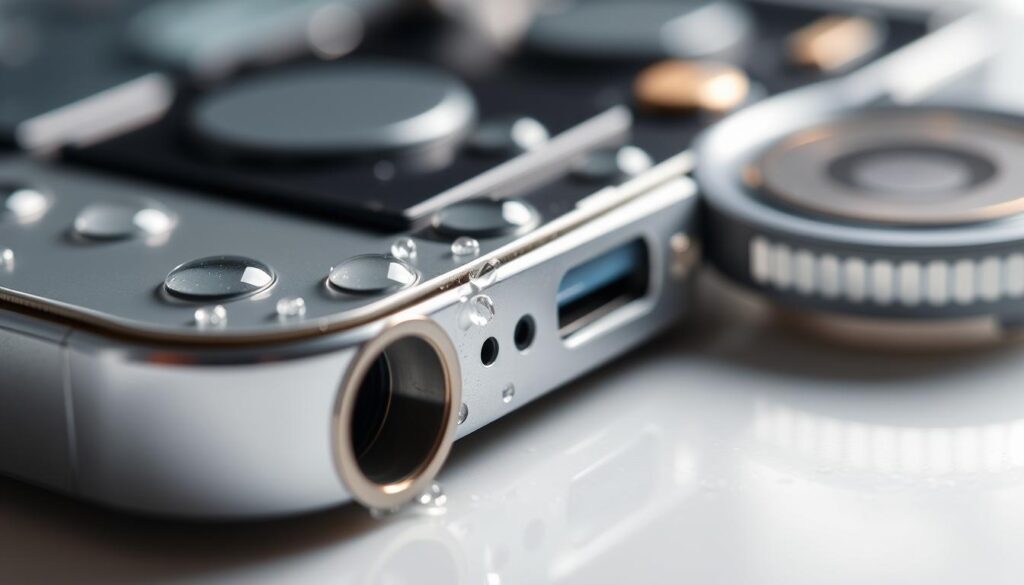
Manual Techniques for Port Drying
There are also ways to dry your iPhone’s ports by hand. Try tapping it gently or using a soft cloth to soak up moisture. For tough cases, use a desiccant or put your iPhone in a dry place. But don’t use heat, like a hairdryer, as it can harm your device.
Here are some manual techniques to try:
- Gently tap your iPhone against your hand to dislodge water from the ports.
- Use a soft, dry cloth to absorb moisture from the exterior and ports.
- Place your iPhone in a dry, well-ventilated area to help it dry out naturally.
By using these methods together, you can get water out of your iPhone’s ports and speakers. This should help your device work right again.
iPhone Models and Water Resistance Ratings
Water resistance in iPhones changes with each model. It’s key to know what your device can handle.
Apple has worked hard to make iPhones more water-resistant. Knowing how each model handles water is important.
Water Resistance in Modern iPhones
Starting with the iPhone 7, Apple has made big improvements. Better design and materials help iPhones resist water and dust better.
- iPhone 7 and later models have some level of water resistance.
- iPhone 11 series and newer models offer enhanced water resistance ratings.
- The latest iPhone models, such as the iPhone 13 and iPhone 14 series, boast even higher IP ratings.
IP Ratings Explained
IP ratings show how well a device protects against solids and liquids. For iPhones, these ratings are key to knowing their water resistance.
An IP68 rating means the device is dust-proof and can handle being underwater. The depth and time it can stay underwater vary by model.
| iPhone Model | IP Rating | Water Resistance Depth/Duration |
|---|---|---|
| iPhone 7 | IP67 | Up to 1 meter for 30 minutes |
| iPhone 13 | IP68 | Up to 4 meters for 30 minutes |
| iPhone 14 Pro | IP68 | Up to 4 meters for 30 minutes |
Limitations of Water Resistance
Even with water resistance, iPhones are not waterproof forever. Over time, wear and tear can reduce this protection.
To keep your iPhone’s water resistance, avoid too much water exposure. Also, take good care of your device.
Dealing with Different Types of Liquid Damage
Not all spills are the same, and the liquid your iPhone gets into can really matter. Knowing how different liquids affect your device is key to fixing it right.
Saltwater vs. Freshwater Exposure
Saltwater and freshwater are two different waters for your iPhone. Saltwater is more corrosive and can damage your device faster. Freshwater is less corrosive but can still harm your electronics. It’s important to act fast no matter the water type.
To fix saltwater damage, rinse with freshwater to remove salt, then dry well. For freshwater, just drying your device is usually enough.
| Type of Water | Corrosiveness | Immediate Action |
|---|---|---|
| Saltwater | High | Rinse with freshwater, then dry |
| Freshwater | Low | Dry the device |
Handling Sticky Liquid Spills (Coffee, Soda, etc.)
Sticky liquids like coffee or soda are hard to deal with. They can clog ports and harm your iPhone’s inside. First, turn off your device to avoid short circuits.
Then, carefully wipe off any extra liquid. Use a soft cloth or cotton swab with distilled water. For deeper cleaning, use special electronics cleaners.
After, dry your device well. You might need desiccants or professional help for big spills. To avoid spills, use protective cases and watch where you drink near your iPhone.
Testing Your iPhone After Drying
After drying your iPhone, it’s key to power it up safely and check how it works. This step is important to see if you’ve successfully removed water from your iPhone.
Safe Power-Up Procedure
First, make sure your iPhone is dry inside and out. Then, insert a dry SIM card or check the SIM card slot is dry. Plug in a charger or insert a dry SIM card. If water damaged your iPhone, it might not turn on right away, so wait patiently.
Some signs your iPhone is working include:
- The screen lighting up
- The Apple logo appearing
- Vibrating or making a sound when you plug it in
Checking Core Functions
Once it’s on, test your iPhone’s main functions. Start by checking the touchscreen by opening apps. Then, play music or a video to test the speakers. Make a call to check the microphone and earpiece. Also, test the camera, Wi-Fi, and Bluetooth if you can.
If you find problems during these tests, it could mean water damaged your iPhone’s inside parts. In this case, it’s best to go to an authorized service center for a professional check.
By carefully testing your iPhone after drying, you can see if you’ve removed water from your iPhone successfully or if you need to do more.
When to Seek Professional Repair
Water damage can be tricky, and sometimes, your iPhone needs a pro’s help. DIY fixes work for small water issues, but big damage needs a pro.
If your iPhone still doesn’t work after drying, it’s time for a pro. Look for these signs to know when to seek help.
Signs of Serious Water Damage
Severe water damage shows in many ways. Look out for:
- Corrosion on the inside parts
- Broken charging ports or other connectors
- Display problems like flickering or black spots
- Issues with the speaker or microphone
- Random shutdowns or not turning on
Apple Support says, “Liquid damage isn’t covered by warranty, but you might get a paid repair.” If your iPhone has these problems, it needs a pro.
“The sooner you act, the better your chances of minimizing damage and potentially saving your device.”
Finding Reputable Repair Services
Finding a good repair service is key. Here’s how:
- Look for authorized Apple Service Providers
- Check online reviews and ratings
- Ask friends or family for tips
- Make sure the service center has good warranty and return policies
| Repair Service | Cost Range | Warranty |
|---|---|---|
| Authorized Apple Service Provider | $100-$300 | 90 days |
| Third-Party Repair Shops | $50-$250 | 30-90 days |
Expected Costs for Professional Water Damage Repair
Repair costs vary based on damage and service. Expect to pay $100 to $300 at an authorized Apple Service Provider. Third-party shops might charge less, from $50 to $250.
Here’s a rough guide to repair costs:
- Screen repair: $100-$200
- Logic board repair: $150-$300
- Water damage diagnostics: $50-$100
When choosing a repair service, think about cost, quality, and warranty. The cheapest might not be the best value in the long run.
Data Recovery Options for Water-Damaged iPhones
When your iPhone gets wet, you worry about losing your data. Luckily, there are ways to get your important info back.
Checking iCloud Backups
If you backed up your iPhone to iCloud, you might be able to get your data back. Here’s how to see if you have a recent backup:
- Go to Settings on your iPhone.
- Tap on [your name].
- Select iCloud.
- Tap on iCloud Backup.
- Check the date of your last backup.
If you have a backup, you can restore your data once your iPhone is fixed.
Professional Data Recovery Services
If iCloud backup isn’t an option, professional services can help. These companies have the tools and know-how to get data from damaged phones. Some top services include:
| Service Provider | Specialization | Success Rate |
|---|---|---|
| Dr. Data | iPhone Data Recovery | High |
| Data Rescue | Water-Damaged Devices | Very High |
| Secure Data Recovery | Complex Data Recovery | Excellent |
Picking a trusted service is key for the best results.
Preventive Backup Strategies
To avoid losing data, it’s smart to back up regularly. Backing up to iCloud or iTunes can save your data. Here are some tips:
- Enable automatic iCloud backups.
- Back up your iPhone to your computer with iTunes.
- Try third-party backup apps for extra safety.
By following these steps, you can keep your data safe, even if your phone gets wet.
Conclusion
Getting water out of your iPhone needs quick action and the right steps. We’ve looked at many ways to fix a waterlogged iPhone. This includes understanding water damage and using methods like the rice method, silica gel, and vacuum.
It’s important to act fast to lessen damage. First, turn off your iPhone, remove accessories, and gently wipe off moisture. Don’t make mistakes like turning on a wet iPhone or using heat.
Using the methods we talked about can help dry out your iPhone. Whether it’s using special drying solutions or manually removing water, be patient and careful. Regular backups and precautions can also help avoid data loss and future damage.
With the right knowledge and steps, you can fix a waterlogged iPhone. By following this guide, you can try to recover your device and avoid future problems.
FAQ
How do I know if my iPhone has water damage?
Look for corrosion, water spots, or condensation inside the screen or camera lenses. Also, check for Liquid Contact Indicators (LCI) that turn red when exposed to water.
Can I charge my iPhone after it’s been exposed to water?
No, don’t charge your iPhone after it gets wet. Charging can cause short circuits and more damage.
Is the rice method effective in drying out a wet iPhone?
The rice method can work, but it’s not always reliable. Make sure to follow the right steps and know its limits.
What is the best way to dry out my iPhone?
Using silica gel packets or a commercial drying solution might be better than rice. You can also try a low-pressure vacuum or sound frequencies to remove water.
How can I remove water from my iPhone’s ports and speakers?
Use water eject shortcuts and apps, or sound frequencies to get rid of water. You can also try tapping the ports gently or using a soft cloth to dry them.
Can I fix my iPhone’s water damage myself?
You might be able to fix it yourself, depending on the damage. But if it’s serious, it’s best to get professional help.
How can I prevent water damage to my iPhone in the future?
Use a waterproof case and be careful near water. Also, back up your data regularly to avoid losing it if your iPhone gets damaged.
What should I do if my iPhone doesn’t turn on after drying?
Try a safe power-up procedure first. If it still doesn’t work, you might need professional repair or Apple support.
Can I recover my data from a water-damaged iPhone?
Check your iCloud backups. If you don’t have one, you might need professional data recovery services to get your data back.
How much does it cost to repair water damage on an iPhone?
The cost depends on the damage, the model, and the repair service. Expect to pay between 0 and 0 or more for professional repairs.
